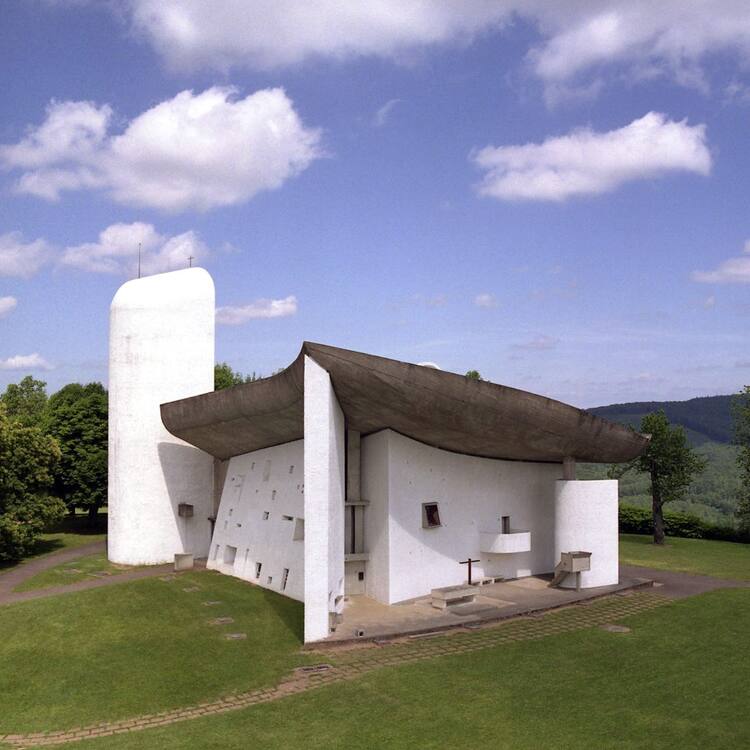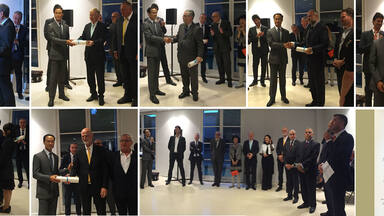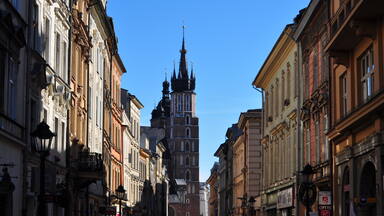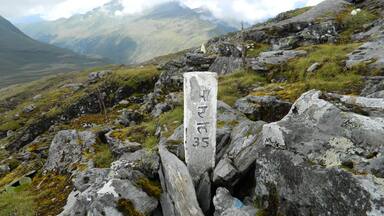The Architectural Work of Le Corbusier, an Outstanding Contribution to the Modern Movement
The Architectural Work of Le Corbusier, an Outstanding Contribution to the Modern Movement
Chosen from the work of Le Corbusier, the 17 sites comprising this transnational serial property are spread over seven countries and are a testimonial to the invention of a new architectural language that made a break with the past. They were built over a period of a half-century, in the course of what Le Corbusier described as “patient research”. The Complexe du Capitole in Chandigarh (India), the National Museum of Western Art, Tokyo (Japan), the House of Dr Curutchet in La Plata (Argentina) and the Unité d’habitation in Marseille (France) reflect the solutions that the Modern Movement sought to apply during the 20th century to the challenges of inventing new architectural techniques to respond to the needs of society. These masterpieces of creative genius also attest to the internationalization of architectural practice across the planet.
Description is available under license CC-BY-SA IGO 3.0
L’Œuvre architecturale de Le Corbusier, une contribution exceptionnelle au Mouvement Moderne
Choisis parmi l’œuvre de Le Corbusier, les 17 sites qui composent ce bien en série transnational, réparti sur sept pays, témoignent de l’invention d’un nouveau langage architectural en rupture avec le passé. Ils ont été réalisés sur un demi-siècle, tout au long de ce que Le Corbusier a nommé une « recherche patiente ». Le Complexe du Capitole à Chandigarh (Inde), le Musée national des Beaux-arts de l’Occident à Tokyo (Japon), la Maison du Docteur Curutchet à La Plata (Argentine) ou encore l’Unité d’habitation de Marseille (France) reflètent les solutions que le Mouvement Moderne a cherché à apporter, au cours du XXe siècle, aux enjeux de renouvellement des techniques architecturales, afin de répondre aux besoins de la société. Ces chefs-d'œuvre du génie humain attestent également de l’internationalisation de la pratique architecturale à l’échelle de la planète.
Description is available under license CC-BY-SA IGO 3.0
الأعمال الهندسية للمهندس
اختير السبعة عشر موقعاً التي يتكوّن منها هذه الأعمال والموزّعة في سبع دول مختلفة لتشهد على اكتشاف لغة جديدة في الفن المعماري، لغة متحرّرة من أنماط الماضي. ويذكر أنه تم بناء هذه المواقع في فترة تمتد لنصف قرن. وأطلق المهندس "لو كوربوزييه" على هذه الفترة اسم "العمل الدؤوب". وإنّ أعمال المهندس "لو كوربوزييه" مثل مجمع الكابيتول في شنغهاي (الهند)، والمتحف الوطني للفنون الغربية الجميلة في طوكيو (اليابان)، وبيت الطبيب كوروتشيت في مدينة لابلاتا (الأرجنتين) والوحدة السكنية في مدينة مارسيليا (فرنسا)، تجسّد الحلول والتقنيات المعماريّة التي يقدّمها فن العمارة الحديثة لمواجهة تحديات العصر وحاجات المجتمع خلال القرن العشرين. كما تشهد هذه المواقع أيضاً على تدويل فن العمارة في جميع أنحاء العالم.
source: UNESCO/CPE
Description is available under license CC-BY-SA IGO 3.0
Архитектурное наследие Ле Корбюзье: выдающийся вклад в модернизм
Серия памятников архитектурного наследия Ле Корбюзье насчитывает 17 объектов в семи странах. Эти памятники свидетельствуют о возникновении решительно нового архитектурного стиля, знаменующего собой полный отход от прошлого. Строительство этих сооружений приходится на полвека, период, который Ле Корбюзье назвал временем «терпеливого поиска». Комплекс капитолия в городе Чандигарх (Индия), национальный музей западного искусства в Токио (Япония), дом доктора Куручета в Ла Плата (Аргентина) и жилой комплекс в Марселе (Франция) отражают предложенные модернизмом в ХХ веке архитектурные приёмы решения задач, выдвигаемых новыми потребностями общества. Эти шедевры человеческого гения также свидетельствуют об интернационализации архитектурного творчества.
source: UNESCO/CPE
Description is available under license CC-BY-SA IGO 3.0
Obra arquitectónica de Le Corbusier – Contribución excepcional al Movimiento Moderno
Repartidos en siete países, los 17 sitios integrantes de este bien del patrimonio mundial constituyen un testimonio de la invención de un nuevo modo de expresión de la arquitectura, en clara ruptura con sus formas anteriores. Las obras arquitectónicas de esos sitios fueron realizadas por Le Corbusier a lo largo de cincuenta años de “búsqueda paciente”, según sus propias palabras. El Complejo del Capitolio de Chandigarh (India), el Museo Nacional de Bellas Artes de Occidente de Tokio (Japón), la casa del Dr. Curutchet en La Plata (Argentina) y la Unidad de Viviendas de Marsella (Francia), entre otras construcciones, ponen de manifiesto las soluciones aportadas en el siglo XX por el Movimiento Moderno al reto de renovar las técnicas arquitectónicas para satisfacer las necesidades de la sociedad. Estas obras maestras del genio humano también constituyen un testimonio de la internacionalización de la arquitectura a escala planetaria.
source: UNESCO/CPE
Description is available under license CC-BY-SA IGO 3.0
ル・コルビュジエの建築作品-近代建築運動への顕著な貢献-
source: NFUAJ
Het architecturale werk van Le Corbusier: een uitmuntende bijdrage aan de Moderne Beweging
Source: unesco.nl
ली कोर्बुज़िए की वास्तुशिल्पीय कृतियां–आधुनिक आंदोलन में एक उत्कृष्ट योगदान
ली कोर्बुज़िए की कलाकृतियों में से 17 ऐसे स्थलों को चुना गया है, जो सात देशों में फैली हुई अंतरराष्ट्रीय क्रमिक संपत्तियों में शामिल हैं और अतीत को पीछे छोड़ते हुए ये नई वास्तुशिल्पीय भाषा के आविष्कार के साक्षी हैं। ये अर्ध-शताब्दी के उस दौर में बनाए गए, जिसे ली कोर्बुज़िए ने “धैर्यशील अनुसंधान” के रूप में वर्णित किया। चंडीगढ़ (भारत) में कॉम्प्लैक्से दू कैपिटोल, टोक्यो (जापान) में पश्चिमी कला का राष्ट्रीय संग्रहालय, द हाउस ऑफ डॉ कुरुटचेट इन ला प्लाटा (अर्जेन्टीना) तथा मर्सिल (फ्रांस) में यूनाइटे दि’ हैबिटेशन के भवन-समूह 20वीं शताब्दी के दौरान समाज की जरूरतों को पूरा करने के लिए, नई वास्तुशिल्पीय तकनीकों के आविष्कार की चुनौतियों को पूरा करने के उद्देश्य से आधुनिक आंदोलन द्वारा ढूंढ़े गए समाधानों को प्रकट करते हैं। रचनात्मक प्रतिभा की ये उत्कृष्ट कृतियां पूरे विश्व में वास्तुशिल्पीय परंपरा के अंतरराष्ट्रीयकरण को भी प्रमाणित करती हैं।
Source: India
Outstanding Universal Value
Brief synthesis
Chosen from the work of architect Le Corbusier that survives in eleven countries on four continents, the sites in seven countries on three continents, implemented over a period of half a century, for the first time in the history of architecture attest to the internationalization of architectural practice across the entire planet.
The seventeen sites together represent an outstanding response to some of the fundamental issues of architecture and society in the 20th century. All were innovative in the way they reflect new concepts, all had a significant influence over wide geographical areas, and together they disseminated ideas of the Modern Movement throughout the world. Despite its diversity, the Modern Movement was a major and essential socio-cultural and historical entity of the 20th century, which has to a large degree remained the basis of the architectural culture of the 21st century. From the 1910s to the 1960s, the Modern Movement, in meeting the challenges of contemporary society, aimed to instigate a unique forum of ideas at a world level, invent a new architectural language, modernize architectural techniques and meet the social and human needs of modern man. The series provides an outstanding response to all these challenges.
Some of the component sites immediately assumed an iconic status and had world-wide influence. These include the Villa Savoye, as an icon for the Modern Movement; Unité d’habitation in Marseille as a major prototype of a new housing model based on a balance between the individual and the collective; Chapelle Notre-Dame-du-Haut for its revolutionary approach to religious architecture; the Cabanon de Le Corbusier as an archetypal minimum cell based on ergonomic and functionalist approaches; and the Maisons de la Weissenhof-Siedlung that became known worldwide, as part of the Werkbund exhibition.
Other sites acted as catalysts for spreading ideas around their own regions, such as Maison Guiette, that spurred the development of the Modern Movement in Belgium and the Netherlands; the Maison du Docteur Curutchet that exerted a fundamental influence in South America; the Musée National des Beaux-Arts de l’Occident as the prototype of the globally transposable Museum of Unlimited Growth which cemented ideas of the Modern Movement in Japan; and the Capitol Complex that had a considerable influence across the Indian subcontinent, where it symbolized India’s accession to modernity.
Many of the sites reflect new architectural concepts, principles, and technical features. The Petite villa au bord du Léman is an early expression of minimalist needs as is also crystallized in the Cabanon de Le Corbusier. Le Corbusier’s Five Points of a New Architecture are transcribed iconically in Villa Savoye. The Immeuble locatif à la Porte Molitor is an example of the application of these points to a residential block, while they were also applied to houses, such as the Cité Frugès, and reinterpreted in the Maison du Docteur Curutchet, in the Couvent Sainte-Marie-de-la-Tourette and in the Musée National des Beaux-Arts de l’Occident. The glass-walled apartment building had its prototype in the Immeuble locatif à la Porte Molitor.
A few sites inspired major trends in the Modern Movement, Purism, Brutalism, and a move towards a sculptural form of architecture. The inaugural use of Purism can be seen in the Maisons La Roche et Jeanneret, Cité Frugès and the Maison Guiette; the Unité d’Habitation played a pioneering role in promoting the trend of Brutalism, while the Chapelle Notre-Dame-du-Haut and the Capitol Complex promoted sculptural forms.
Innovation and experimentation are reflected in the independent structure of concrete beams of the Maisons de la Weissenhof-Siedlung, while pre-stressed reinforced concrete was used in the Couvent de La Tourette. In the Capitol Complex, concern for natural air-conditioning and energy saving led to the use of sunscreens, double-skinned roofs, and reflecting pools for the catchment of rainwater and air cooling.
Standardisation is seen in the Unité d’Habitation de Marseille, a prototype intended for mass production, while the Petite villa au bord du Lac Léman set out the standard for a single span minimal house, and the Cabanon de Le Corbusier presented a standard, minimum unit for living. The modulor, a harmonic system based on human scale, was used for the exterior spaces of the Complexe du Capitole, which reflect the silhouette of a man with raised arm.
The idea of buildings designed around the new needs of ‘modern man in the machine age’ is exemplified in the light new workspaces of Manufacture à Saint-Dié, while the avant-garde housing at the Cité Frugès, and the low-rent Maisons de la Weissenhof-Siedlung, demonstrate the way new approaches were not intended for a tiny fraction of society but rather for the population as a whole. By contrast, the Immeuble Clarté was intended to revolutionise middle class housing. The Athens Charter, as revised by Le Corbusier, promoted the concept of balance between the collective and the individual, and had its prototype in the Unité d’habitation, while the Capitol Complex, the focal point of the plan for the city of Chandigarh, is seen as the most complete contribution to its principles and to the idea of the Radiant City.
Criterion (i): The Architectural Work of Le Corbusier represents a masterpiece of human creative genius, providing an outstanding response to certain fundamental architectural and social challenges of the 20th century.
Criterion (ii): The Architectural Work of Le Corbusier exhibits an unprecedented interchange of human values, on a worldwide scale over half a century, in relation to the birth and development of the Modern Movement.
The Architectural Work of Le Corbusier revolutionized architecture by demonstrating, in an exceptional and pioneering manner, the invention of a new architectural language that made a break with the past.
The Architectural Work of Le Corbusier marks the birth of three major trends in modern architecture: Purism, Brutalism and sculptural architecture.
The global influence reached by The Architectural Work of Le Corbusier on four continents is a new phenomenon in the history of architecture and demonstrates its unprecedented impact.
Criterion (vi): The Architectural Work of Le Corbusier is directly and materially associated with ideas of the Modern Movement, of which the theories and works possessed outstanding universal significance in the twentieth century. The series represents a “New Spirit” that reflects a synthesis of architecture, painting and sculpture.
The Architectural Work of Le Corbusier materializes the ideas of Le Corbusier that were powerfully relayed by the International Congress of Modern Architecture (CIAM) from 1928.
The Architectural Work of Le Corbusier is an outstanding reflection of the attempts of the Modern Movement to invent a new architectural language, to modernize architectural techniques, and to respond to the social and human needs of modern man.
The contribution made by the Architectural Work of Le Corbusier is not merely the result of an exemplary achievement at a given moment, but the outstanding sum of built and written proposals steadfastly disseminated worldwide through half a century.
Integrity
The integrity of the series as a whole is adequate to demonstrate the way Le Corbusier’s buildings reflect not only the development and influence of the Modern Movement but the way they were part of its transmission around the world.
The integrity of most of the component sites is good. At Cité Frugès, within the property, new buildings on three parcels of the site - one of which included a standardised house by Le Corbusier, which was destroyed during the war - are inconsistent with the architect’s concepts. At Villa Savoye and the adjacent gardener’s house, integrity is partly compromised by the Lycée and sports fields built on three sides of the original meadow that surrounded the villa in the 1950s. The setting of this site is fragile. At the Maisons de la Weissenhof-Siedlung, war-time destruction and post-war reconstruction has led to the collective integrity of the model settlement being affected by the loss of ten houses out of twenty-one.
At the Chapelle Notre-Dame-du-Haut, where Le Corbusier’s structure was built over a centuries-old pilgrimage site, the integrity of the site has been partly compromised by a new visitor centre and a nunnery near the chapel that cut Le Corbusier’s structure from its contemplative hillside setting.
At the Immeuble locatif à La Porte Molitor, a new rugby stadium has been constructed right in front of the glass façade of the apartment block.
Authenticity
The series clearly demonstrates how it adds up to more than the sum of its component parts.
For most of the individual component sites, the authenticity is good in relation to how well the attributes of the site can be said to reflect the overall Outstanding Universal Value of the series. At Cité Frugès, on three plots traditional houses were constructed replacing Corbusian structures, while elsewhere in the urban landscape, there is a partial loss of authenticity through neglect and interior changes. At l’Unité d’habitation, the fire of 2012 destroyed a small part of the building. This has now been totally reconstructed to the original design, but with some reduction in authenticity. The authenticity of the existing Capitol Complex could be impacted if either or both of the governor’s palace or the museum of knowledge were to be constructed, an eventuality that has apparently been discussed.
At the Musée National des Beaux-Arts de l’Occident, the original intention for the forecourt of the Museum appears to be as a wide open space. Forecourt planting in 1999 tends to detract from the presentation of the building, its key views and the setting.
Recent developments at Chapelle Notre-Dame-du-Haut have partly compromised the authenticity of the site in terms of its ability to convey Le Corbusier’s ideas. At the Immeuble locatif à La Porte Molitor the new stadium has detracted from the ability of the glass walls of this site to convey its value, although without diminishing its authenticity.
In terms of materials, some sites have been restored and partly reconstructed in recent years, after neglect or disfigurement. Overall, the modifications can be seen to be reasonable and proportionate.
Protection and management requirements
Many of the components received early protection, mostly in the two decades following Le Corbusier’s death. Some, like the Maisons de la Weissenhof-Siedlung in Stuttgart and the Unité d’habitation in Marseille, were given protection during Le Corbusier’s lifetime. The nomination dossier sets out for each component the relevant forms of legislative protection. All component sites are protected at a national/federal level and their buffer zones are adequately protected by either legislation or planning mechanisms. Given the importance of detail and setting for these 20th century buildings, it is crucial that their protection is sufficiently encompassing and sensitive to allow for protection of interiors, exteriors, context and setting.
In most of the sites, conservation measures are appropriate and are based on long-standing conservation experience and methodology. Conservation work is programmed and entrusted to specialists with high levels of skill and expertise. Conservation treatment is combined with regular maintenance, including the involvement of inhabitants, local communities, and public associations. There are conservation issues in the Chapelle Notre-Dame-du-Haut. There is now an urgent need to implement the agreed conservation programme. There is also an urgent need for a Conservation plan to be prepared for the Capitol Complex.
A Standing Conference has been established for the overall series and will coordinate the management of the property, advise States Parties and implement actions for promotion and enhancement of the property. An Association of Le Corbusier Sites has been set up to bring together all the local authorities in whose territories sites have been nominated. Its main objectives are coordination, raising public awareness, sharing conservation experience, overall coordination and management of the series, and implementation of management plans for each of the component sites. The involvement of the expertise of the Fondation Le Corbusier – that has the moral rights over Le Corbusier’s oeuvre – is crucial for appropriate management and conservation of the series, especially in those cases where the properties are in private hands other than the Fondation. Within France, Switzerland and Argentina coordinating committees have been set up to oversee the management of sites in those countries.
What remains unclear is how dialogue is undertaken between countries in relation to sensitive development projects. There would be a need for contributing States Parties to have knowledge of, and opportunities to comment on, proposed development in a component site that might compromise the value of the overall series.
Local management plans have been drawn up for each component site. These have been implemented on a partnership basis between owners and the cultural, heritage and planning departments of the local authorities in whose area they are sited. At the Chapelle Notre-Dame-du-Haut, the management system needs strengthening to ensure the security of the site. At the Maison du Docteur Curutchet a municipal decree for the expansion of the buffer zone and active protection of its environment has been sanctioned.
Given the special problems associated with the conservation of 20th century architecture, a continuous involvement of (inter)national specialists on the conservation of Modern architectural heritage is also essential. In Switzerland the federal administration can call such specialized experts for advice to support the local conservationists (and has done so already). A similar approach is highly recommended for other countries.
The current staffing levels and levels of expertise and training are high in all sites and mechanisms to allow liaison between sites have been put in place. Nonetheless, there appears to be a need for more capacity building on the processes of impact assessment and a need to formalise and clearly define conservation approaches and procedures across the series.
Model monitoring indicators developed for two properties in Switzerland will be developed for the rest of the series by the end of 2016.
Links
-
Deutsche UNESCO-Kommission
-
Villa Le Lac Le Corbusier
-
Le Corbusier - World Heritage
-
Association of Le Corbusier Sites
-
Cité Frugès - Le Corbusier (in French)
-
Couvent de la Tourette
-
Home - Site le Corbusier
-
Town of Firminy (in French)
-
Association des Habitants de l'UH Le Corbusier Marseille (in French)
-
Cap Moderne
-
The chapel Notre-Dame du Haut
-
Le Corbusier / l'Usine Verte à Saint-Dié-des-Vosges (in French)
-
Villa Savoye in Poissy
-
The Foundation - Le Corbusier
-
Huis Guiette
-
Facebook - Casa Curutchet
-
Le Corbusier (in German)
-
The serial inscription of the Architectural Work of Le Corbusier on the World Heritage List
-
The National Museum of Western Art, Tokyo



